Chapter 13 - Sleep and Dreams (copy)
1/50
There's no tags or description
Looks like no tags are added yet.
Name | Mastery | Learn | Test | Matching | Spaced |
|---|
No study sessions yet.
51 Terms
What does the Reticular activating system (RAS) do?
It regulates wakefullness.

What are the 4 Biological Rhythms we have and what do they regulate?
Circannual — yearly
hibernation, fat metabolism, migration of birds, mating in animals.
Infradian — longer than a day, shorter than a year
menstrual cycle
Circadian — daily
sleep-wake cycle, body temperature, blood pressure, stress and growth hormones
Ultradian — shorter than a day
eating
What are the 2 types of Biological rhythms we have?
Endogenous rhythms
are driven internally (biological clock)
from within the body
Exogenous rhythms
are driven externally
e.g. by the sun or the seasons
How can you test if a rhythm is endogenous or exogenous?
Keep the external conditions constant.
e.g. put someone 24/7 in continuous (dim) light or darkness and keep the temperature constant.
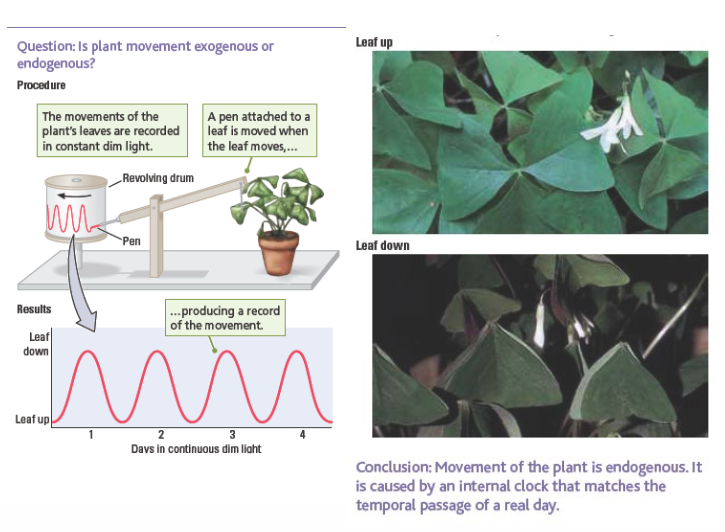
What happens if humans determine their own sleep-wake rhythm?
Day-night period extended to 25-27 hours and shifted 1-2 hours every night → free-running rhythm.
New experiment in constant twilight showed that humans have an endogenous free-running period; this is somewhat longer than 24h (24h 11m).
humans do have a biological clock, but this is slightly defect.
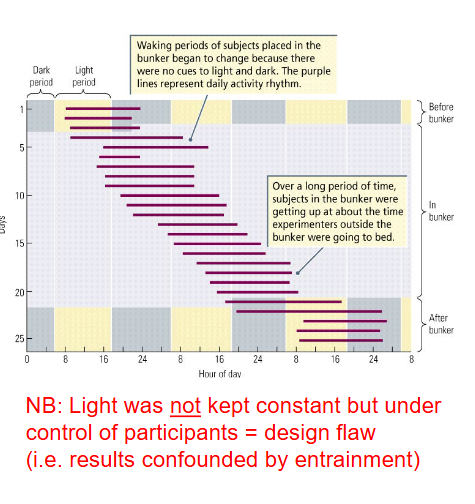
How does the length of free-running period vary across species?
Diurnal animals: darkness extends, lightness contracts (more active).
Nocturnal animals: darkness contracts (more active), lightness extends.
What are Zeitgebers?
Environmental events that provide a clock-setting cue (e.g. daylight).
Periodical synchronization to such environments (zeitgebers) keeps our biological clock on the 24-hour track.

What is Entrainment?
The synchronization (resetting) process to zeitgebers.
When does Jet leg arise?
When the Zeitgeber (daylight) is not synchronized with the biological clock.
The clock must be entrained to a different time-zone.
Entrainment works best if the adjustment is not too large.
NB: adjustment is more difficult from west to east than from east to west.
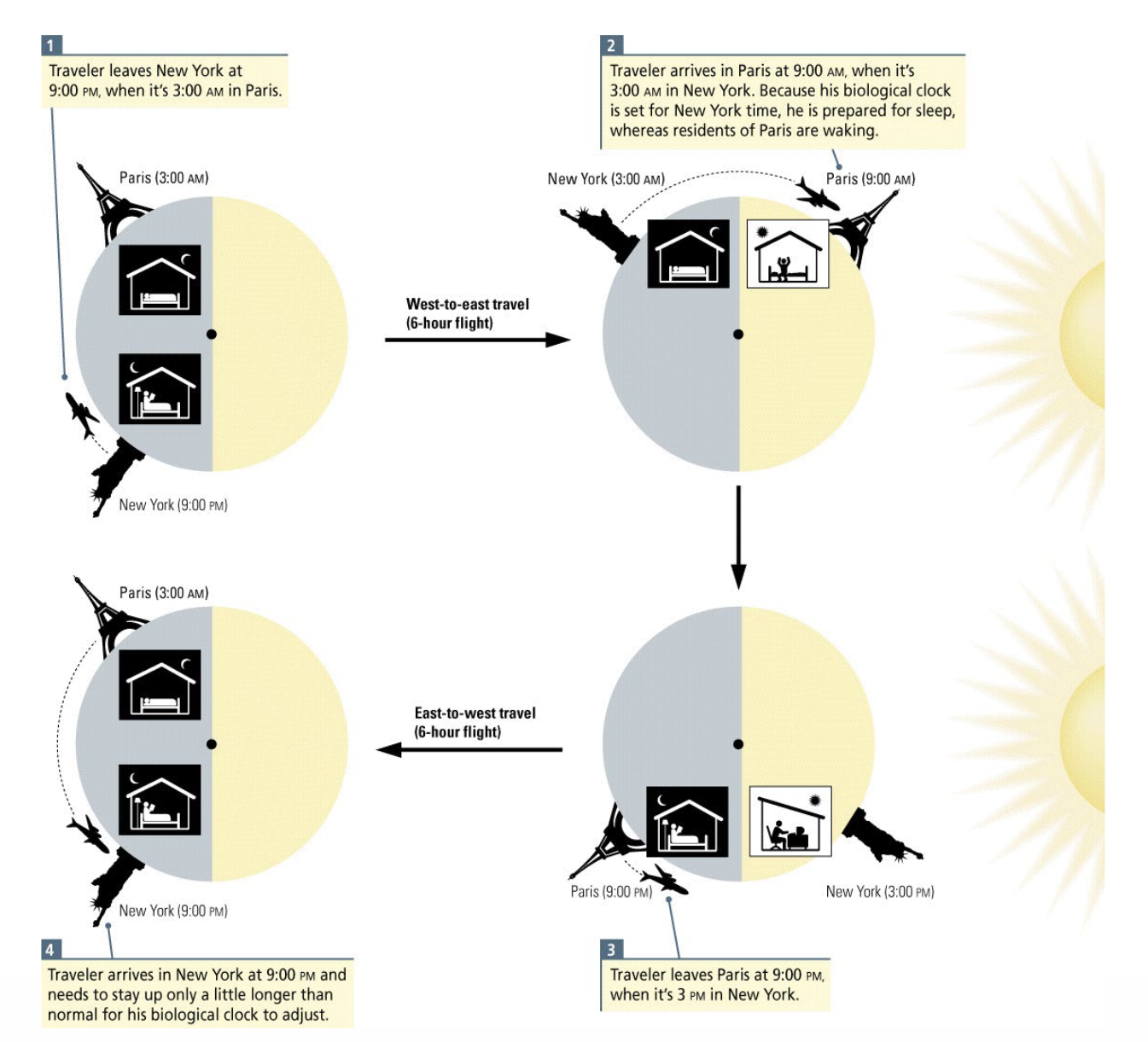
What is the most important biological clock structure? Where is it located?
Suprachiasmatic nucleus (SCN)
Part of the hypothalamus.
The SCN is located just above the optic chiasm
Supra chiasma
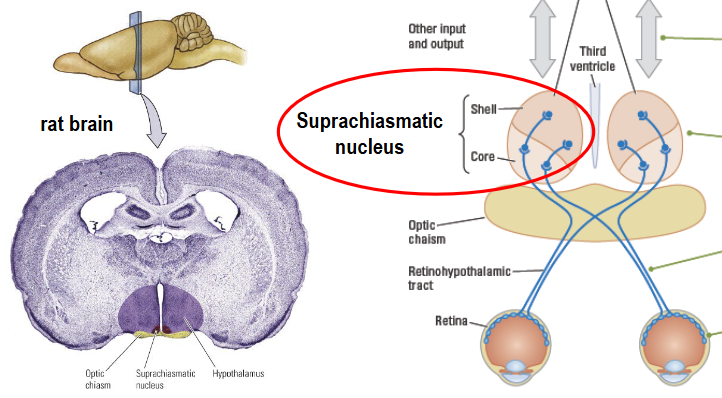
What does the SCN receive input from? Via which tract does this travel?
From photosensitive retinal ganglion cells (pRGCs).
Via the retinohypothalamic tract.
Core neurons are not rhythmic; is this statement correct?
YES; they entrain shell neurons which are genetically programmed for rhythmicity.
note: being a night owl or early bird is caused by a preference from the entrain shell neurons.
if you want to change the time you wake up, you need to change your environment.
What is the SCN’s circadian rhythm usually entrained by?
By morning and evening light, but can also be entrained or disrupted by nonphotic events, including:
Arousal
Movement
Feeding
By what are nonphotic events signaled to the SCN?
By the intergeniculate leaflet (lateral thamalus) and Raphé nuclei (serotonergic pathway, see ch5).
NB: explains why late-night snacking might disrupt circadian rhythm.
The SCN produces behavior.
Is this statement correct?
NO; the SCN itself does not produce behavior.
e.g. eating still occurs after lesion, but not at regular times.
What does the SCN act as?
A biological “Master Clock”.
it contains pacemaker cells that have an endogenous rhythm of ~24h.
What are “Slave Oscillators”?
It follows the “Master Clock”; the pacemaker cells in there entrain “Slave Oscillators”; other brain structures with circadian rhythmic activity.
e.g. during night (darkness): pineal gland → melatonin.
e.g. during day (lightness): pituitary gland → adrenal glands → cortisol

What does Melatonin do? What does Cortisol do?
Melatonin = activates the parasympathetic rest-and-digest system.
Cortisol = supports arousal activities in the sympathetic system (see ch 6).
What is Melatonin secreted by and what role does it have?
Secreted by the pineal gland and plays a role in:
The circadian sleep-wake cycle (animals and humans)
In many animals also in circannual cycles (e.g. bird migration, reproduction, hibernation, etc.).
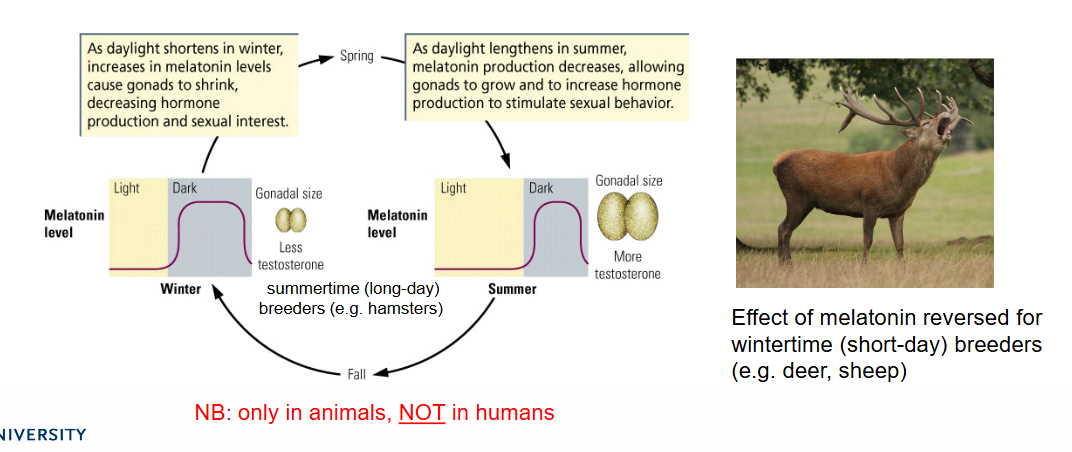
What are the 3 main electrical body signals that are required to reliably record sleep?
Brain activity
Electro-encephalography (EEG)
Muscle activity
Electro-myogram (EMG)
Eye movement
Electro-oculogram (EOG)
Additional measures: body temperature, circulating hormones, blood glucose levels.
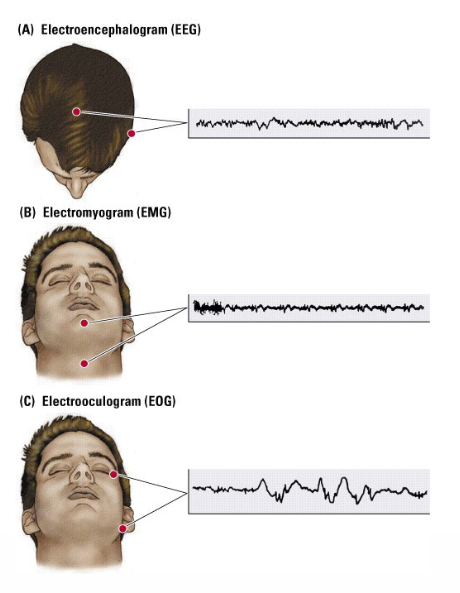
What are the sleep stages based on?
On the analysis of EEG, EMG and EOG activity (amplitude and frequency).
Based on EEG activity, there appear to be five different states of activation (states of consciousness).
Based on EEG activity, there appear to be five different states of activation (states of consciousness).
What are these 5 stages?
W Waking
beta rhythm (eyes open)
alpha rhythm (eyes closed)
N1 NREM Stage 1
theta rhythm (sleep onset)
N2 NREM Stage 2
sleep spindles, K-complexes (asleep)
N3 NREM Stage 3
delta rhythm (deep/slow-wave sleep)
R REM
beta/theta rhythm (~Waking/NREM Stage 1)
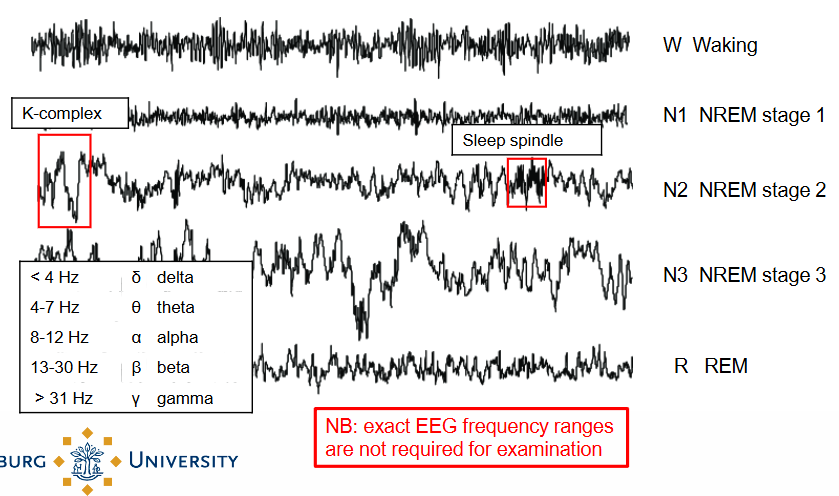
What are the 3 (strange) things that happen After NREM Stage 3?
The brain seems to wake up (EEG frequency increases, and looks similar to Waking/NREM Stage 1).
The muscles are maximally relaxed (atonia), suggesting deep sleep.
The EOG shows (horizontal) Rapid Eye Movement (REM), and mouth, fingers and toes may twitch.
NB: Movement of eyes, face, fingers and toes during REM sleep help maintain blood flow and may be related to development of coordinated movements and tuning of neural motor circuits (esp. in children)
What happens when the EEG frequency increases?
The brain seems to be waking up; there is more activity.
What is Atonia?
When the muscles are maximally relaxed.
What is the Paradoxical sleep?
The REM Sleep stage is also called paradoxical sleep because of the ‘awake’ EEG and ‘sleeping’ EMG.

What are the differences in NREM sleep and REM sleep?
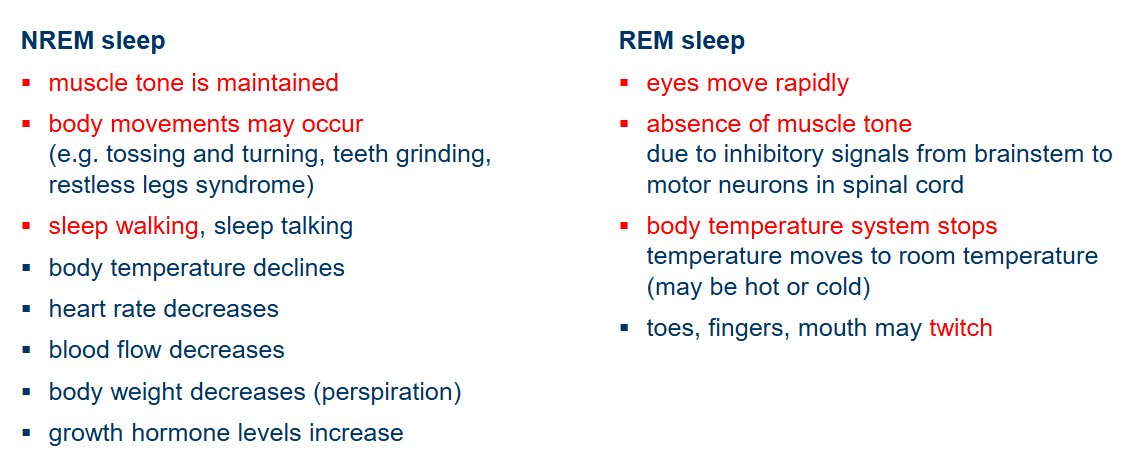
What is a Hypnogram?
A graph that represents the stages of sleep as a function of time.
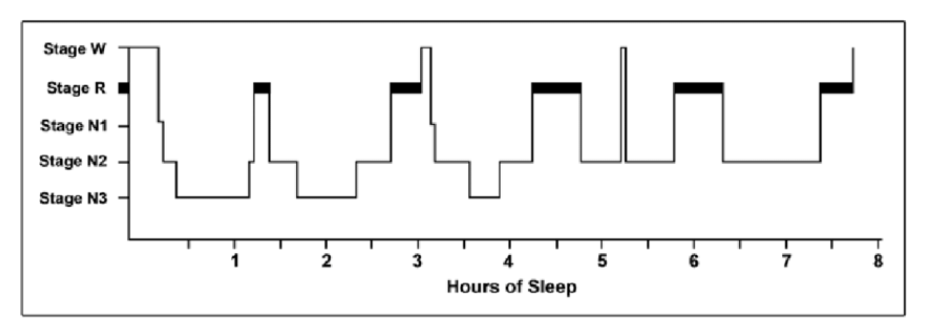
How can the Sleep stages of a night be expressed in a Hypnogram?
First halve of a typical night is mainly characterized by NREM sleep, second halve mainly REM sleep.
NREM-REM sequence last ~90 minutes and occurs ~5 times a night.
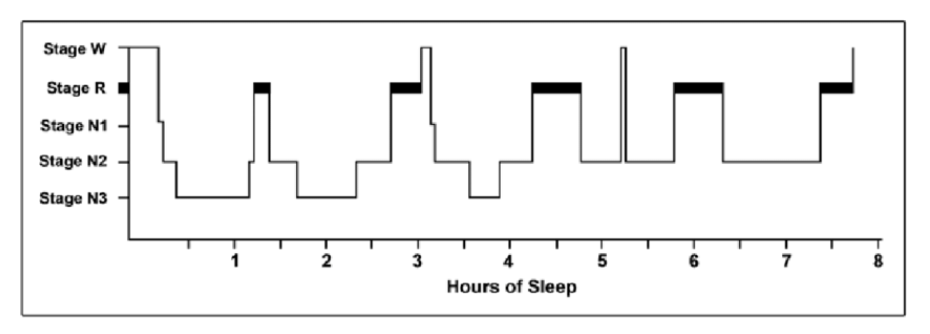
When does REM-rebound happen?
If you do not sleep long enough (or at all) one night, the REM sleep occurs at the beginning of the following night → REM-rebound.

How does Sleep change over the Life span? Name 3 changes.
Most people sleep less as they grow older.
The amount of REM sleep decreases significantly with age.
Children from the age of ~2 years show a REM sleep pattern that resembles that of adults.
From roughly this age onwards, they also start to dream and remember things.
The hippocampus is largely myelinated around this age.
NB: These findings support the relationship between REM sleep, dreaming and memory.
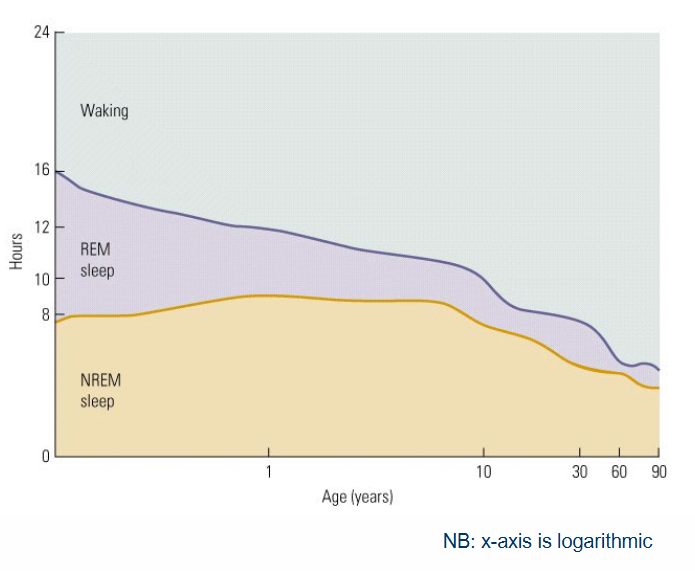
In which Sleeping stage does Dreaming mainly occur?
During REM sleep → the brain is more active during REM sleep.
Waking people during REM sleep: ~80% reports a vivid dream.
Waking people during NREM sleep: ~10% reports a dream, but much less vivid.
note: people that are active during the night (more muscle activity) have difficulty getting in REM sleep.
What is the difference between a Nightmare and a Night terror?
Nightmare = a long frightening dream that awakens a sleeper from REM sleep.
Night terror = a brief frightening dream that occurs during NREM sleep (stage 3) marked by intense fear and automatic activation.
Dreams appear to take place in real time; what are the 2 findings supporting this?
Performing an action in a dream lasts about as long as it would take to perform while awake.
Perceptual ‘shrinking’ of time is probably a perceptual product of remembering a dream just as time compression is a feature of our recall of other memories.
What are the 3 (old) theories about the Function of dreaming? Who are the 3 corresponding founders of these theories?
Ancient Egyptians: Dreams are oracles, messages from the gods.
Sigmund Freud: Dreams are symbolic fulfilment of unconscious wishes (ex. sexual desires that you weren’t able to do during the day, ex. we dream about things we fear).
Carl Jung: Dreams are collective unconscious that includes the history of the entire human race.
What are the 3 more recent theories explaining the function of dreaming from a scientific approach?
Activation-synthesis theory (Hobson, 2004)
Dreams are an epiphenomenon of random brain activity.
note: the brain is active during the day, during dreams the brain is just randomly making connections?
Coping theory (Valli & Revonsuo, 2009)
Dreams are biologically adaptive and lead to enhanced coping strategies for threatening life events.
note: dreaming prepares you for something that is about to happen.
Continuation theory (Edwards, 2013)
We are problem solvers while awake, and this continues during sleep.
NB: Exact function of dreaming is still not fully understood.
What is the Basic Rest-Activity Cycle (BRAC)?
In humans, activity and rest are organized in time blocks of ~90 minutes.
REM sleep also occurs at similar intervals → Evidence for Continuation theory.
Atonia (loss of muscle tone) during REM sleep ~ brakes that stop an idling car at traffic light from moving.

What are the 4 theories about the Function of sleep?
Sleep as a biological adaptation process
Animals sleep to save energy
Diurnal animals sleep to avoid bumping into objects at night
Predators typically sleep more than prey animals
Sleep as restorative process
Body recovery: e.g. growth hormone during sleep (NREM)
Brain recovery: resting state and cleaning up (restore plastic abilities)
Sleep and explicit memory storage (conscious: episodic, semantic)
In rats, explicit memory traces in the hippocampus are consolidated during NREM sleep.
Sleep and implicit memory storage (unconscious, e.g motor skills, habits)
In humans, consolidation of implicit memory seems to occur during REM sleep.
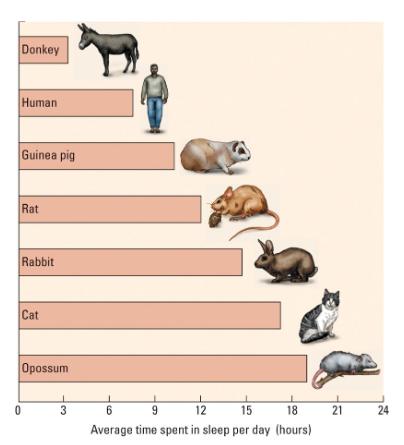
What happens with Chronic sleep deprivation?
Impaired cognitive functioning (sustained attention deficits).
When does REM Sleep deprivation happen? What is the result of having this?
Side effect of many antidepressants and sedatives, including alcohol.
Apart from REM-rebound, no short-term effects on cognitive functioning.
What is the evidence for Explicit memory storage in rats?
Place cells in the hippocampus fire on a certain place in
space during navigation behavior (e.g., search for food).These firing sequences are repeated during NREM
sleep.note: conscious things you do during the day, are played back during the sleep which can account for the storage of information → memory.
NB: important (conscious) daytime events are seemingly
“played back” during NREM sleep and probably stored in
long-term explicit memory
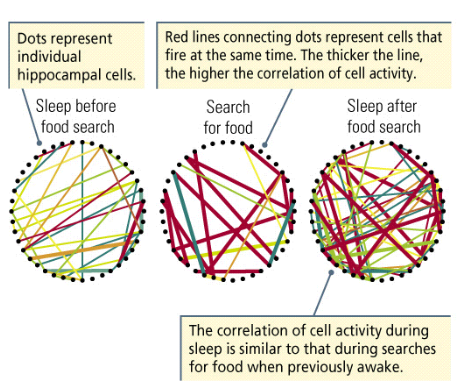
When does consolidation of Implicit memory happen in humans?
During REM sleep.
note: dorsal stream (how) is activated during the task and during the playing back of the memory during REM sleep.

What is the main brain area responsible for sleep-waking behavior? Where is this area found?
The Reticular activating system (RAS)
In brainstem (see ch2).
note: reticular, because it is net-shaped.

What does Stimulation vs. Inhibition of the RAS do?
Stimulation = stimulates the (hypo)thalamus and cortex and produces an awake EEG pattern.
Inhibition = produces a sleep EEG pattern.
What does damage to the RAS result in?
Coma → prolonged state of deep unconsciousness resembling sleep.
note: but it can lead to death.
What is the Neural bases of the Sleep-wake regulation?
The ventrolateral preoptic nucleus (VLPO) in the hypothalamus contains a sleep-wake switch controlled by the suprachiasmatic nucleus (SCN, master clock)
The switch is OFF when awake, RAS is active → induces awake EEG pattern
The switch is ON during sleep (NREM and REM), inhibits the RAS → induces sleep EEG pattern

Where is the Cholinergic system located and what does it do?
Nucleus basalis of Meynert.
Waking EEG associated with being alert yet still.
Where is the Serotonergic system located and what does it do?
Raphé Nuclei.
Waking EEG associated with movement.
What happens if both the Cholinergic and Serotonergic systems are destroyed?
There will be no intelligent behavior.
What are the 2 NREM Sleep disorders?
Insomnia = difficulty or inability to fall asleep or stay asleep (common in anxiety and depression)
Hypersomnia = difficulty waking up or staying awake, excessively tired while awake due to prolonged NREM sleep (deep sleep)
What are the 3 REM Sleep disorders?
Narcolepsy = suddenly fall asleep at unwanted times and places (no NREM, directly to REM sleep)
Sleep paralysis = being unable to move (paralyzed) due to waking up at REM sleep on/offset, when muscles are relaxed (atonia)
Cataplexy = sudden loss of muscle tone (collapse), triggered by arousal (e.g. happy emotions) = REM sleep attack during wakefulness
note: these people literally fall to the ground.
NB: Sleep paralysis and Cataplexy often co-occur with Narcolepsy.